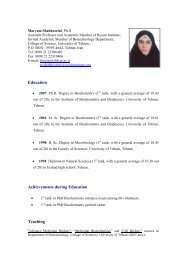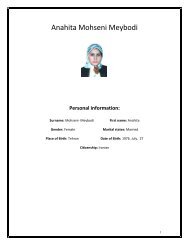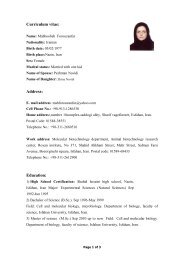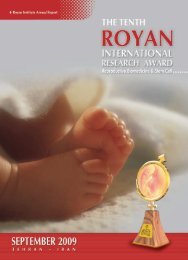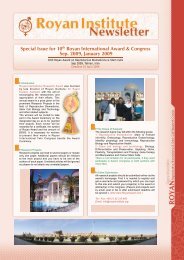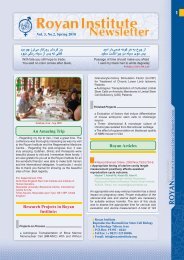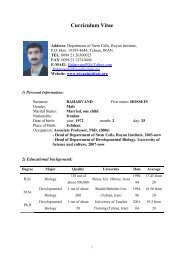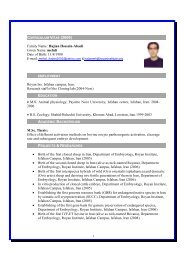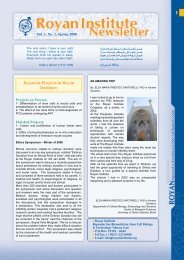Royan International Research Award - Royan Institute
Royan International Research Award - Royan Institute
Royan International Research Award - Royan Institute
- No tags were found...
Create successful ePaper yourself
Turn your PDF publications into a flip-book with our unique Google optimized e-Paper software.
The Eleventh ROYAN<strong>International</strong> <strong>Research</strong> <strong>Award</strong>WINNERS<strong>International</strong>Winner<strong>International</strong> WinnerHuman neural stem cells ameliorateautoimmune encephalomyelitisin non-human primatesStefano Pluchino, MD, PhDItalyRegenerative MedicineAfter receiving his MD (1995) and PhD in Neuroscience (2004) from the University of Siena, Italy, Stefano Pluchino has completeda residency program in Neurology at the same University and received additional training at the Brain Repair Centre, CambridgeUniversity, UK (1996-1998). He has then completed a Postdoctoral fellowship in Experimental Neurology at the Neuroimmunology Unitof the San Raffaele Scientific <strong>Institute</strong>, Milan, Italy (2005), where he’s progressed to the positionof <strong>Research</strong> Associate (2005) and thenGroup Leader of the CNS Repair Unit (2008). Dr Pluchino also holds a non-tenured Professorship in Regenerative Neuroscience at theUniversity Vita & Salute, of the San Raffaele Scientific <strong>Institute</strong>, Milan, Italy (since 2005) and an Adjunct Associate Professorship inNeurology at the University of Vermont College of Medicine, Burlington, VT, USA (since 2008).Stefano Pluchino has recently (2010) been appointed to a John Van Geest University lectureship in Brain Repair at the University ofCambridge, within the Centre for Brain Repair in the Department of Clinical Neurosciences. The major contribution of Dr Pluchino’sstudies has been the demonstration of the [constitutive vs inducible] immune modulatory functions of somatic neural stem/precursor cells(NPCs). This seminal observation has lead to a number of pre-clinical studies where NPCs injected trough biological routes, such as theblood stream and the cerebrospinal fluid, protect the nervous system from accumulation of chronic tissue damage (therapeutic plasticityof stem cells). His major recent focus has been the exploitation of the cellular and molecular mechanisms regulating the therapeuticplasticity of neural progenitor cells in inflammatory CNS diseases such as multiple sclerosis, ischemic stroke, and spinal cord injury.Having established this, current research projects are exploring the different modalities by which NPCs engage programs of horizontalcell-to-cell communication with cells in the microenvironment (more information are available on http://pluchino.brc.cam.ac.uk).Objective:Transplanted neural stem/precursor cells (NPCs) display peculiar therapeutic plasticity in vivo. Although the replacementof cells was first expected as the prime therapeutic mechanism of stem cells in regenerative medicine, it is now clear thattransplanted NPCs simultaneously instruct several therapeutic mechanisms, among which replacement of cells might notnecessarily prevail. A comprehensive understanding of the mechanism(s) by which NPCs exert their therapeutic plasticityis lacking. This study was designed as a preclinical approach to test the feasibility of human NPC transplantation in anoutbreed nonhuman primate experimental autoimmune encephalomyelitis (EAE) model approximating the clinical andcomplex neuropathological situation of human multiple sclerosis (MS) more closely than EAE in the standard laboratoryrodent.Material and Methods:We examined the safety and efficacy of the intravenous (IV) and intrathecal (IT) administration of human NPCs in commonmarmosets affected by human myelin oligodendrocyte glycoprotein 1-125–induced EAE. Treatment commenced upon theoccurrence of detectable brain lesions on a 4.7T spectrometer.Results:EAE marmosets injected IV or IT with NPCs accumulated lower disability and displayed increased survival, as comparedwith sham-treated controls. Transplanted NPCs persisted within the host central nervous system (CNS), but were also foundin draining lymph nodes, for up to 3 months after transplantation and exhibited remarkable immune regulatory capacity invitro.Conclusion:Herein, we provide the first evidence that human CNS stem cells ameliorate EAE in nonhuman primates without overtside effects. Immune regulation (rather than neural differentiation) is suggested as the major putative mechanism by whichNPCs ameliorate EAE in vivo. Our findings represent a critical step toward the clinical use of human NPCs in MS.Keywords:neural stem cells, transplantation, multiple sclerosis39



